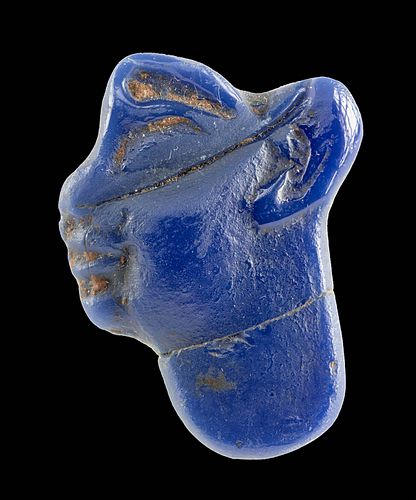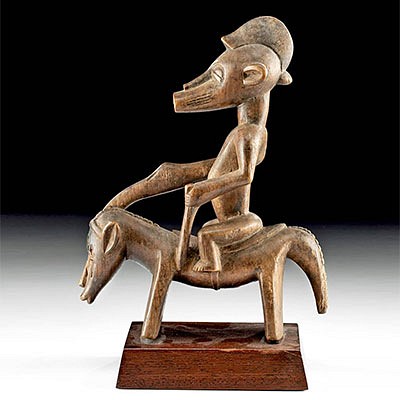Egyptian Sebennytic Ptolemaic Glass Profile Face Inlay
Lot 1
About Seller
Artemis Fine Arts
686 S Taylor Ave, Ste 106
Louisville, CO 80027
United States
Selling antiquities, ancient and ethnographic art online since 1993, Artemis Gallery specializes in Classical Antiquities (Egyptian, Greek, Roman, Near Eastern), Asian, Pre-Columbian, African / Tribal / Oceanographic art. Our extensive inventory includes pottery, stone, metal, wood, glass and textil...Read more
Categories
Estimate:
$4,000 - $6,000
Absentee vs Live bid
Two ways to bid:
- Leave a max absentee bid and the platform will bid on your behalf up to your maximum bid during the live auction.
- Bid live during the auction and your bids will be submitted real-time to the auctioneer.
Bid Increments
| Price | Bid Increment |
|---|---|
| $0 | $25 |
| $300 | $50 |
| $1,000 | $100 |
| $2,000 | $250 |
| $5,000 | $500 |
| $10,000 | $1,000 |
| $20,000 | $2,500 |
| $50,000 | $5,000 |
| $100,000 | $10,000 |
| $200,000 | $20,000 |
About Auction
By Artemis Fine Arts
Feb 17, 2022
Set Reminder
2022-02-17 10:00:00
2022-02-17 10:00:00
America/New_York
Bidsquare
Bidsquare : CLEARANCE | Ancient & Ethnographic Art
https://www.bidsquare.com/auctions/artemis-gallery/clearance-ancient-ethnographic-art-8898
Join us for our first clearance sale of the year featuring discounted pricing and many new items! Asian art, Classical antiquities from Egypt, Greece, Italy, and the Near East...plus Pre-Columbian, Tribal, Spanish Colonial, Fine Art, Fossils, more! Artemis Fine Arts info@artemisgallery.com
Join us for our first clearance sale of the year featuring discounted pricing and many new items! Asian art, Classical antiquities from Egypt, Greece, Italy, and the Near East...plus Pre-Columbian, Tribal, Spanish Colonial, Fine Art, Fossils, more! Artemis Fine Arts info@artemisgallery.com
- Lot Description
**Originally Listed At $4000**
Egypt, city of Sebennytos, Late Period, 30th Dynasty to early Ptolemaic Period, Sebennytic-Ptolemaic type, ca. 4th to early 3rd century BCE. A stunning mold-cast facial profile inlay formed from opaque glass of a sumptuous cobalt-blue hue. The left-facing profile features shallow impressions that form the almond-shaped eye, sloping brow, and stylized ear details. Full lips and a plump chin are set slightly lower than the smooth cheek, and the short neck terminates in a smooth semicircle. The visage has a rounded base that would have fit into a larger composite figural inlay as it perhaps represents a pharaoh based on how the petite recess between the eyebrow and ear was meant to receive a separate glass headdress. A delicate and rare example of exceptional glass artistry! Size: 0.8" W x 1.1" H (2 cm x 2.8 cm); 1.3" H (3.3 cm) on included custom stand.
The Thirtieth Dynasty is characterized by a myriad of scholars as being one of the last great periods of ancient Egyptian dynastic rule. The seat of the pharaoh in the Thirtieth Dynasty was situated in the Lower Egyptian city of Sebennytos located on the Damietta (Sebennytic) branch of the Nile Delta. According to authors E. Marianne Stern and Birgit Schlick-Nolte, "Egyptian art reached its last peak under the Thirtieth Dynasty. Well aware of the power of images, Ptolemy adopted Egyptian art forms and Egyptian ceremony to justify his rule in the eyes of the Egyptian people. The traditional Egyptian art forms continued from the Thirtieth Dynasty into the third century B.C., providing the name Sebennytic-Ptolemaic for the art of this period. Subsequently, the influence of Greek style elements significantly increased. Several stylistic features of [profile inlays] are characteristic of the Sebennytic-Ptolemaic style: the receding eyebrow, prominent mouth with pursed lips, golf-ball chin, and long neck with a curving edge." (Stern, E. Marianne and Birgit Schlick-Nolte. "Early Glass of the Ancient World: 1600 B.C. - A.D. 50 | Ernesto Wolf Collection." Verlag Gerd Hatje, Germany, 1994, p. 340)
For a nearly identical example facing to the right, please see: Stern, E. Marianne and Birgit Schlick-Nolte. "Early Glass of the Ancient World: 1600 B.C. - A.D. 50 | Ernesto Wolf Collection." Verlag Gerd Hatje, Germany, 1994, p. 342, no. 106.
For a stylistically similar example exhibiting a green hue, please see The Metropolitan Museum of Art, accession number 66.99.186.
A stylistically similar example, of a slightly larger size and shaped from turquoise-hued glass, hammered for $22,705 at Christie's, New York "Antiquities" auction (sale 1384, June 8, 2004, lot 112).
Provenance: ex-Dr. Sid Port collection, California, USA, acquired in the 1980s
All items legal to buy/sell under U.S. Statute covering cultural patrimony Code 2600, CHAPTER 14, and are guaranteed to be as described or your money back.
A Certificate of Authenticity will accompany all winning bids.
PLEASE NOTE: Due to recent increases of shipments being seized by Australian & German customs (even for items with pre-UNESCO provenance), we will no longer ship most antiquities and ancient Chinese art to Australia & Germany. For categories of items that are acceptable to ship to Australia or Germany, please contact us directly or work with your local customs brokerage firm.
Display stands not described as included/custom in the item description are for photography purposes only and will not be included with the item upon shipping.
#153162Neck reattached to bottom of head, with small chips and light adhesive residue along break line. Light abrasions to face and neck, with light brown weathering material within some recessed areas, and minor softening to some finer details. Light earthen deposits and fine remaining detailing throughout.Condition
- Shipping Info
-
All shipping is handled in-house for your convenience. Your invoice from Artemis Gallery will include shipping calculation instructions. If in doubt, please inquire BEFORE bidding for estimated shipping costs for individual items.
-
- Buyer's Premium



 EUR
EUR CAD
CAD AUD
AUD GBP
GBP MXN
MXN HKD
HKD CNY
CNY MYR
MYR SEK
SEK SGD
SGD CHF
CHF THB
THB
















